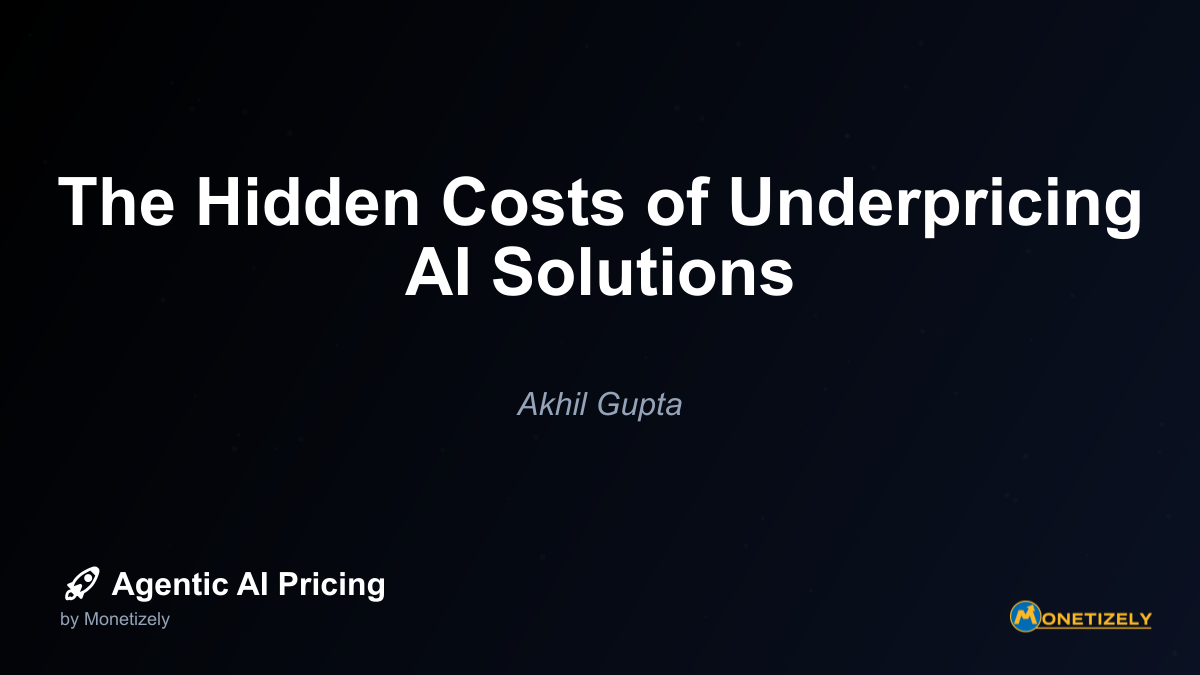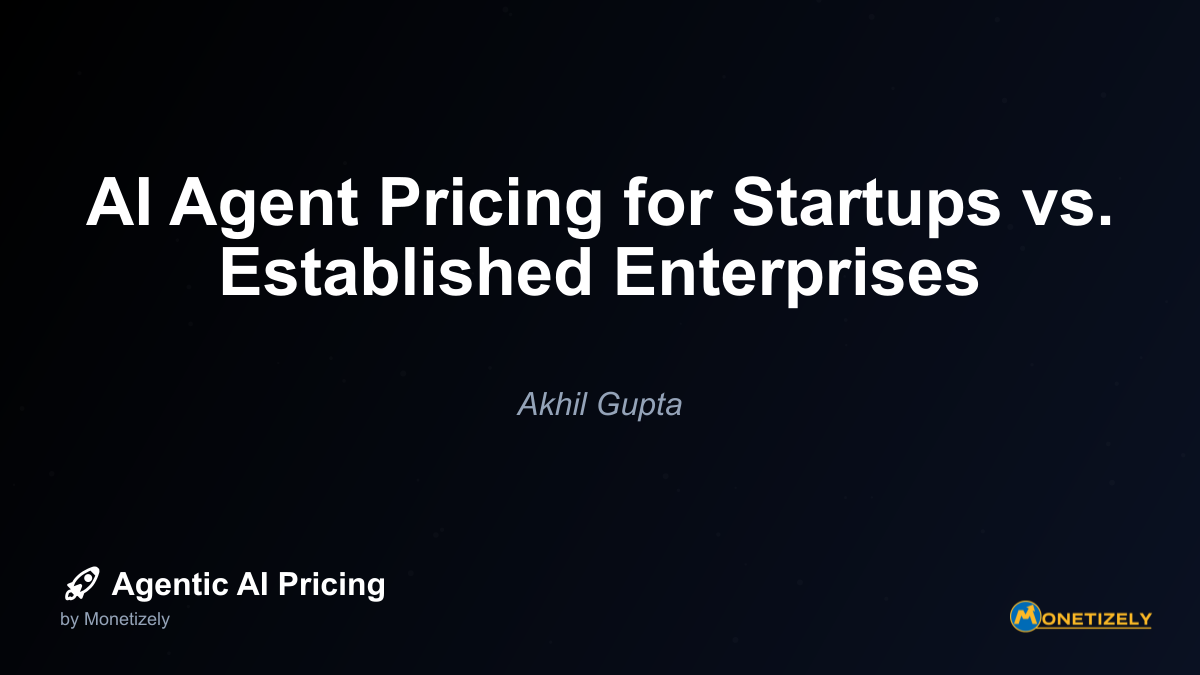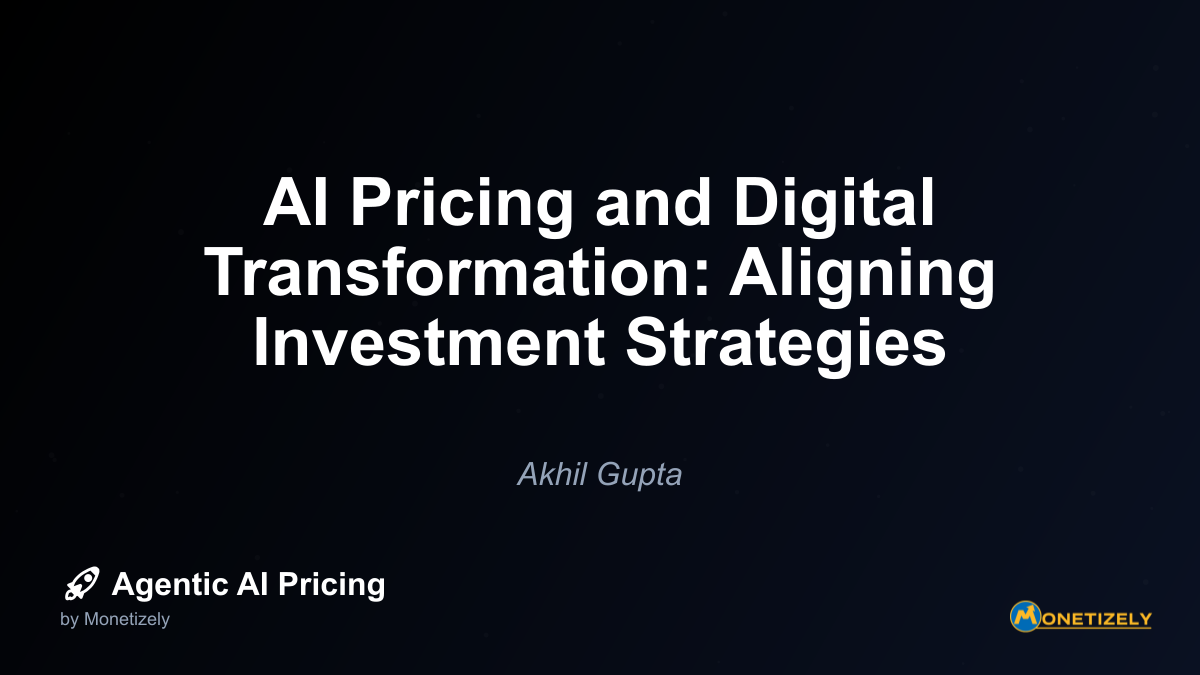· Akhil Gupta · Strategy · 7 min read
The Hidden Costs of Underpricing AI Solutions
AI and SaaS Pricing Masterclass
Learn the art of strategic pricing directly from industry experts. Our comprehensive course provides frameworks and methodologies for optimizing your pricing strategy in the evolving AI landscape. Earn a professional certification that can be imported directly to your LinkedIn profile.

Financial Implications of Underpricing AI Solutions
While the immediate impact of underpricing on revenue is obvious, the long-term financial consequences are often more complex and damaging than anticipated.
The Challenge of Price Correction
One of the most significant hidden costs of underpricing is the difficulty of implementing price increases once a low anchor has been established. Customers who have become accustomed to certain price points typically resist increases, even when they’re objectively justified by added value or market conditions.
This creates a pricing trap where:
- Incremental increases face strong resistance
- Significant price adjustments lead to customer churn
- Grandfathering old pricing creates margin disparities
- Introducing new pricing tiers fragments the customer experience
- Explaining price changes consumes significant communication resources
Many AI solution providers find themselves locked into unsustainable pricing models for years because the cost of correction seems greater than continuing with compressed margins.
Investor Perception and Valuation Impact
For AI companies seeking investment or considering exit strategies, pricing strategy significantly impacts valuation metrics. Underpricing creates several challenges from an investment perspective:
- Lower revenue projections despite user growth
- Compressed margin expectations
- Questions about long-term sustainability
- Concerns about market positioning
- Doubts about management’s strategic capabilities
Investors increasingly evaluate AI companies not just on user acquisition but on their ability to capture appropriate value. Underpricing signals potential weakness in this critical capability.
Customer Acquisition Cost Imbalance
Many companies justify low prices as a customer acquisition strategy, but this approach creates dangerous economic imbalances. When prices are too low, the lifetime value (LTV) of customers may not adequately cover the cost of acquiring them (CAC), especially in competitive AI markets where acquisition costs are rising.
This imbalance forces companies to:
- Pursue aggressive upselling strategies that may alienate customers
- Extend payback periods to unsustainable lengths
- Seek additional funding to cover operational gaps
- Cut costs in ways that compromise quality
- Focus excessively on retention at the expense of innovation
Market Positioning Consequences
Strategic pricing is a crucial component of market positioning. Underpricing can fundamentally alter how your AI solution is perceived in the competitive landscape, often in ways that limit long-term potential.
The Commoditization Trap
When AI solutions compete primarily on price rather than unique value, they accelerate the commoditization of their category. This creates several problematic outcomes:
- Reduced focus on differentiation and innovation
- Increased customer price sensitivity
- Lower switching costs between providers
- Difficulty establishing sustainable competitive advantages
- Vulnerability to new market entrants with lower cost structures
Once a category becomes commoditized, escaping the resulting price pressure becomes extraordinarily difficult, even with significant innovation.
Market Segmentation Limitations
Strategic pricing should reflect intentional market segmentation decisions. Underpricing often represents an implicit decision to target price-sensitive segments, which may not align with the solution’s capabilities or the company’s long-term vision.
This misalignment creates several challenges:
- Attracting customers who continue to prioritize price over value
- Missing opportunities in higher-value market segments
- Creating brand associations that are difficult to change
- Limiting partnership opportunities with premium providers
- Constraining future product development directions
Competitive Response Dynamics
Underpricing often triggers competitive responses that can damage the entire category. When one provider significantly undercuts market rates, competitors typically respond with their own price reductions, creating a downward spiral that benefits no one except customers in the short term.
These price wars:
- Reduce overall market revenue potential
- Shift focus from value creation to cost-cutting
- Limit industry-wide investment in innovation
- Create unsustainable operating models
- Damage customer expectations around appropriate pricing
How to Escape the Underpricing Trap
If you recognize that your AI solution is currently underpriced, transitioning to a more sustainable model requires careful planning and execution. While challenging, this transition is essential for long-term viability.
Value Articulation and Demonstration
The foundation of any price correction strategy is a renewed focus on articulating and demonstrating the value your AI solution delivers. This involves:
- Quantifying concrete outcomes and ROI for existing customers
- Creating case studies that highlight value rather than cost savings
- Developing ROI calculators that make the value exchange transparent
- Training sales and marketing teams to discuss value confidently
- Refining messaging to emphasize capabilities rather than affordability
When customers clearly understand the value they receive, price sensitivity naturally decreases.
Segmented Transition Strategies
Rather than implementing across-the-board price increases, consider segmented approaches that minimize disruption:
- Grandfather existing customers while implementing new pricing for new acquisitions
- Create premium tiers with enhanced features that justify higher price points
- Develop specialized versions for different market segments with appropriate pricing
- Introduce outcome-based pricing models for segments where value is easily measured
- Implement price increases with extended notice periods and clear value justification
The goal is to gradually shift your customer base and revenue model toward sustainability without triggering massive churn.
Competitive Repositioning
Escaping the underpricing trap often requires fundamentally repositioning your solution in the competitive landscape:
- Identify and emphasize unique capabilities that justify premium positioning
- Focus marketing efforts on segments that value these differentiators
- Create comparison frameworks that highlight value rather than price
- Develop partnerships that enhance perceived premium positioning
- Consider category creation strategies that separate you from price-focused alternatives
This repositioning should be comprehensive, touching everything from product development to marketing communications to sales approaches.
Developing Sustainable AI Pricing Strategies
To avoid the underpricing trap entirely, AI solution providers should develop pricing strategies grounded in value rather than competitive pressure or internal cost structures.
Value-Based Pricing Approaches
Value-based pricing represents the most sustainable approach for sophisticated AI solutions. This methodology focuses on the economic value your solution creates for customers rather than your costs or competitor prices.
Implementing value-based pricing requires:
Identifying value metrics: Determine how customers measure the value they receive (time saved, revenue generated, risks mitigated, etc.)
Quantifying value creation: Develop frameworks to estimate how much economic value your solution creates for different customer segments
Setting value capture targets: Determine what percentage of created value is appropriate to capture through pricing
Creating aligned pricing structures: Design pricing models that align with how customers experience value (subscription, usage-based, outcome-based, etc.)
Developing value communication: Create sales tools and marketing materials that clearly articulate the value exchange
As value-based pricing models for agentic AI continue to evolve, companies that master this approach gain significant advantages in both market positioning and financial performance.
Tiered Pricing Optimization
Well-designed tiering strategies allow AI solution providers to address different market segments appropriately while maximizing overall revenue. Effective tiering involves:
- Creating meaningful capability differentiation between tiers
- Pricing the middle tier as the intended landing point for most customers
- Using decoy pricing to make premium tiers more attractive
- Limiting the number of tiers to prevent decision paralysis
- Designing clear upgrade paths as customer needs evolve
Tiering should reflect genuine differences in value delivery rather than arbitrary feature limitations designed solely to force upgrades.
Dynamic and Usage-Based Models
The operational nature of AI solutions often makes them ideal candidates for dynamic and usage-based pricing models that better align costs with value creation:
- Consumption-based pricing tied to processing volume or API calls
- Outcome-based pricing linked to measurable customer results
- Hybrid models combining base subscriptions with usage components
- Peak/off-peak pricing reflecting resource availability
- Value-adjusted usage pricing based on the type of AI functionality utilized
These models can help avoid both underpricing and overpricing by creating natural alignment between value delivered and revenue captured.
The Strategic Importance of Pricing Governance
Preventing underpricing requires more than just good initial strategy—it demands ongoing pricing governance and discipline. Companies should establish:
- Clear pricing approval processes with appropriate executive oversight
- Regular pricing review cadences tied to market and cost changes
- Discount management policies with appropriate controls
- Competitive intelligence frameworks to contextualize pricing decisions
- Value quantification methodologies to support pricing discussions
Without these governance mechanisms, even well-designed pricing strategies can erode through incremental concessions and reactive decisions.
Conclusion: The True Cost of Underpricing
The hidden costs of underpricing AI solutions extend far beyond immediate revenue impact. From quality perception to operational constraints, from talent challenges to market positioning limitations, underpricing creates cascading negative effects that can fundamentally undermine business sustainability.
As the AI solutions market continues to mature, providers must resist the temptation to compete primarily on price. Instead, the focus should shift to articulating unique value, demonstrating concrete outcomes, and capturing appropriate value through sophisticated pricing strategies.
Companies that master this approach will not only achieve better financial results but will contribute to a healthier ecosystem where innovation is properly valued and rewarded. In contrast, those that continue down the path of underpricing risk finding themselves trapped in unsustainable business models that ultimately benefit neither themselves nor the broader market.
The most successful AI solution providers understand that pricing is not merely a tactical decision but a strategic lever that shapes everything from market perception to operational capabilities. By treating pricing with the strategic importance it deserves, these companies avoid the underpricing trap and position themselves for sustainable long-term success in the dynamic AI solutions landscape.
Co-Founder & COO
Akhil is an Engineering leader with over 16+ years of experience in building, managing and scaling web-scale, high throughput enterprise applications and teams. He has worked with and led technology teams at FabAlley, BuildSupply and Healthians. He is a graduate from Delhi College of Engineering and UC Berkeley certified CTO.
Pricing Strategy Audit
Let our experts analyze your current pricing strategy and identify opportunities for improvement. Our data-driven assessment will help you unlock untapped revenue potential and optimize your AI pricing approach.




